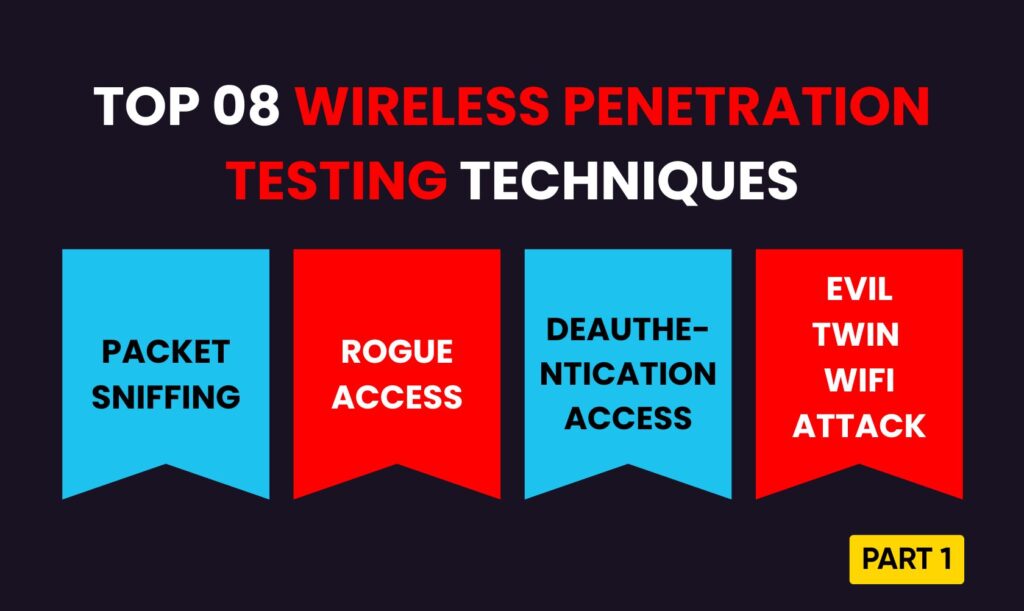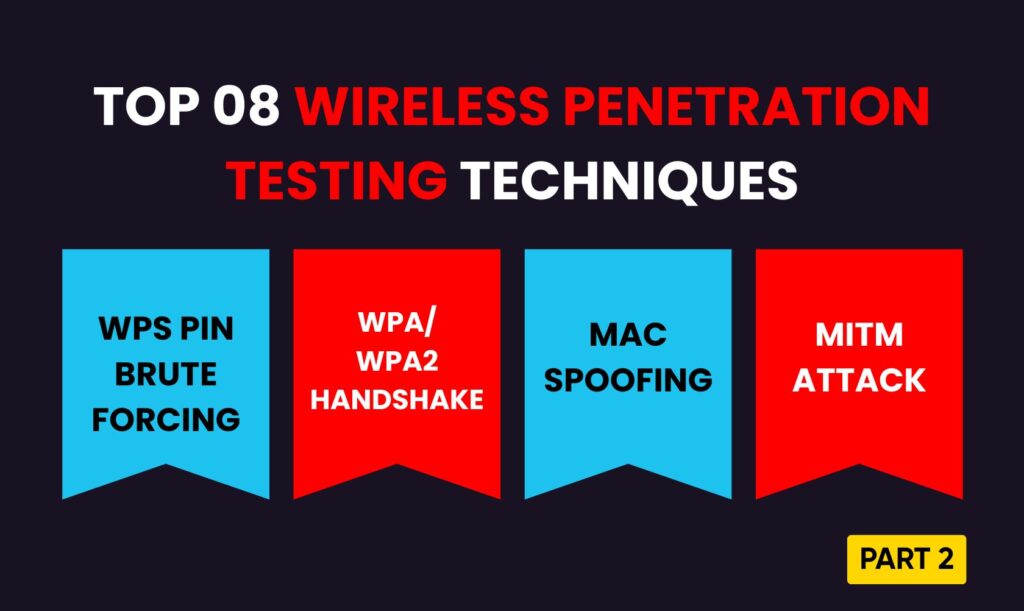Table of Contents
In this article, we’ll examine 8 Top 8 Wireless Penetration Testing: Techniques that are most-liked and successful methods for identifying and taking advantage of wireless network vulnerabilities: penetration testing. Knowing how attackers operate and how to defend yourself against them necessitates using strategies like handshake cracking, packet sniffing, and the establishment of rogue access points. Whether you’re learning about ethical hacking or safeguarding a company’s wireless network, this article will give you a helpful overview of real wireless attack methods and how they reveal hidden network security weaknesses.
Packet Sniffing & Traffic Analysis in Wireless Network

An essential tool for wireless penetration testing is packet sniffing, which is the process of collecting and examining data packets as they go across a network. Using tools like Wireshark or tcpdump to capture wireless traffic can reveal private data like session tokens, unencrypted login passwords, or internal communications. Understanding security faults and how to prevent them requires this technology, which helps discover vulnerabilities like unsecured or misconfigured networks and offers comprehensive insights into how data moves through a system.
Rogue Access Point Creation
A rogue access point is a fake wireless network that is configured to look like a real one in order to trick unaware consumers into connecting. Once linked, the attacker can monitor, intercept, or alter all of their traffic. This method is frequently applied in public places where people might not be able to confirm the legitimacy of the Wi-Fi networks that are available. The creation of rogue access points highlights the necessity for robust authentication procedures and user awareness in wireless contexts and demonstrates how readily confidence in open networks may be abused.
Deauthentication Attack: Switching Off Wi-Fi Devices
A deauthentication attack is a method that takes advantage of an error in the 802.11 protocol to disconnect devices from a Wi-Fi network by sending fake deauth packets. Once it has been made to rejoin, the device starts a fresh handshake with the access point. Using programs like airodump-ng, this handshake can be recorded and then utilized in offline password-cracking attempts. It’s a widely used technique to assess WPA/WPA2 security and find wireless network flaws.
Visit what-is-network-penetration-testing
Evil Twin Wi-Fi Attack: When Trust becomes Threat
An Evil Twin attack involves creating a fake Wi-Fi access point that looks and sounds like a real one in order to fool people in nearby towns into connecting to it. Once connected, the attacker’s system receives all user traffic, giving them the ability to intercept private information such as emails, browser history, and login credentials. This approach is frequently used combined with phishing pages or SSL stripping to take advantage of users’ trust in well-known network names and steal confidential data without their awareness.
WPS PIN brute-forcing, Exploiting Weak Access Points

Targeting routers with Wi-Fi Protected Setup (WPS) enabled, WPS PIN brute-forcing takes advantage of a design weakness that enables attackers to repeatedly guess the eight-digit PIN. Because there are only two pieces to the PIN validation, there are far less possible combinations, which makes brute-force attacks quicker and more efficient. This procedure is automated by tools like as Reaver, which let attackers to obtain the WPA/WPA2 passphrase without capturing a handshake. This reveals vulnerable access points that depend on antiquated or unsafe setups.
WPA/WPA2 Handshake Capture and Cracking
Wi-Fi security can be tested by intercepting the connection process between a device and a router using a technique called WPA/WPA2 handshake capture. A four-step process known as a handshake occurs when a device joins, and it can be recorded with programs like airodump-ng. Once captured, the Wi-Fi password can be guessed offline by employing dictionary or brute-force attacks to decrypt this handshake. Strong passwords are crucial for security because weak passwords can be easily discovered.
MAC Spoofing & BSSID Manipulation
MAC spoofing and BSSID manipulation are techniques used to bypass wireless security controls. By changing the MAC address of a device, an attacker can evade MAC filtering, which is meant to allow only approved devices on a network. Additionally, manipulating the BSSID—the unique identifier of a Wi-Fi access point—allows the attacker to impersonate a legitimate network. This can trick devices into connecting to a rogue access point, opening the door to data interception or further attacks.
Man-in-the-Middle (MITM) Attacks over Wireless Networks
A Man-in-the-Middle (MITM) attack represents a category of cyberattack in which a hacker covertly intercepts and may modify the exchange of information between two parties who think they are communicating directly with one another. The attacker occupies a central position in the data exchange—such as between a user and a website or a device and a server—and is able to capture sensitive information like login credentials, banking details, or private messages. Such attacks are frequent on unsecured public Wi-Fi networks, which facilitates attackers’ ability to monitor communications or insert harmful data without detection.
Also Visit Wi-Fi Pentesting Guide
Conclusion
Though wireless networks provide mobility and flexibility, they are frequently targeted by cyberattacks because of their built-in weaknesses. By employing methods such as packet sniffing, creating rogue access points, conducting deauthentication attacks, and performing handshake cracking, ethical hackers can identify vulnerabilities that could be targeted by malicious individuals. The main objective of wireless penetration testing is to recognize and resolve these weaknesses prior to their exploitation. Nonetheless, it is essential that such tests are carried out within legal limits and with the appropriate permissions.
Also Visit Navigating threat landscape
What is the primary objective of testing for wireless penetration?
The purpose of wireless penetration testing is to find and address Wi-Fi network vulnerabilities before malicious attackers may take advantage of them. It ensures that the network is appropriately set and safeguarded and aids in evaluating the efficacy of current security measures.
Is it legal to employ wireless penetration testing techniques?
Only when properly authorized, as in the course of expert security audits or ethical hacking evaluations, are these methods lawful. Conducting them on networks without authorization is prohibited and regarded as a criminal.
What are the most popular tools for testing wireless penetration?
A few popular tools are Reaver for WPS assaults, Bettercap or Ettercap for MITM attacks, Wireshark for packet sniffing, and aircrack-ng for handshake capture and cracking. These tools assist in simulating actual attacks to identify wireless network vulnerabilities.



